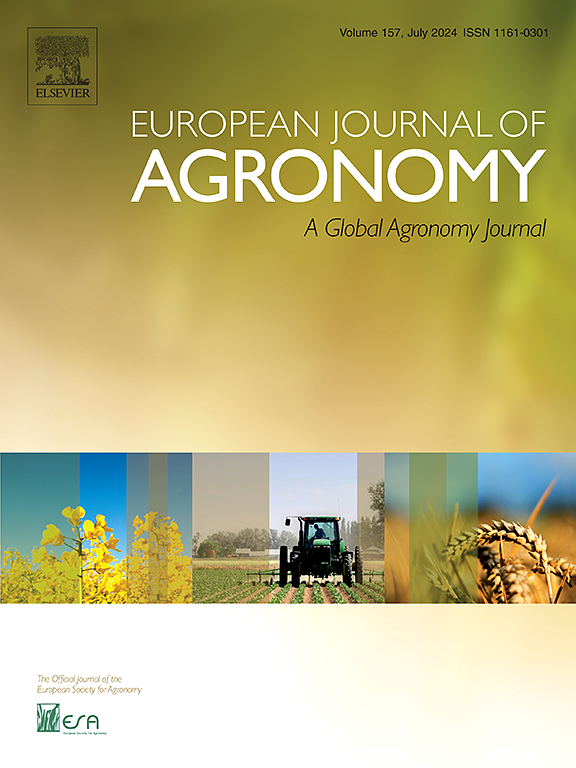揭示1981年以来中国作物物候期热单位的大幅增加
IF 5.5
1区 农林科学
Q1 AGRONOMY
引用次数: 0
摘要
热单位(TU)是作物的重要遗传性状,也是作物模型中的参数。了解TU的变化对于更好地理解气候适应和加强作物模式模拟至关重要。然而,趋势在涂在大规模在很大程度上仍未知,导致传统作物建模框架假设一个固定的你。在这里,使用记录多个作物(小麦、水稻和玉米)物候日期和品种在206 agro-meteorological站在中国从1981年到2018年,我们发现(1)的数量为春小麦品种平均达到10,14对冬小麦,18对早稻,17单大米,16个,晚稻11春玉米,1981 - 2018年,全国夏玉米品种13个,套种玉米品种17个。(2)春小麦、冬小麦、早稻、单稻、晚稻、春玉米、夏玉米和套种玉米全生育期TU显著增加(P <; 0.05),分别为5.68、2.44、2.48、2.38、1.67、5.31、1.16、3.78°C d/a。(3)显著正相关(R >;小麦、水稻和玉米全生育期平均温度与TU之间的关系为0.40,P < <; 0.01)。这种基于观测的证据有助于育种者跟上气候变化的步伐,以确保粮食安全,并支持全球作物模型的开发。本文章由计算机程序翻译,如有差异,请以英文原文为准。
Uncovering the large increases of thermal units during crop phenological phases in China since 1981
Thermal unit (TU) is a critical genetic trait of crops and parameter in crop models. Understanding changes in TU is essential to better comprehend climate adaptation and enhance crop model simulations. However, trends in the field TU at a large scale remain largely unknown and lead to traditional crop modeling framework assuming a fixed TU. Here, using the records for multiple crop (wheat, rice and maize) phenological dates and varieties at 206 agro-meteorological stations across China from 1981 to 2018, we found that (1) the number of varieties on average reached 10 for spring wheat, 14 for winter wheat, 18 for early rice, 17 for single rice, 16 for late rice, 11 for spring maize, 13 for summer maize and 17 for interplanting maize from 1981 to 2018 across China, respectively. (2) TU of these successively replaced varieties during the whole growing period significantly (P < 0.05) increased by 5.68, 2.44, 2.48, 2.38, 1.67, 5.31, 1.16, 3.78 °C d/a for spring wheat, winter wheat, early rice, single rice, late rice, spring maize, summer maize and interplanting maize across China, respectively. (3) The significantly positive correlations (R > 0.40, P < 0.01) between mean temperature and TU during the whole growing period for wheat, rice and maize were found. This observation-based evidence assists breeders in keeping pace with climate change to ensure food security and supports global crop model development.
求助全文
通过发布文献求助,成功后即可免费获取论文全文。
去求助
来源期刊

European Journal of Agronomy
农林科学-农艺学
CiteScore
8.30
自引率
7.70%
发文量
187
审稿时长
4.5 months
期刊介绍:
The European Journal of Agronomy, the official journal of the European Society for Agronomy, publishes original research papers reporting experimental and theoretical contributions to field-based agronomy and crop science. The journal will consider research at the field level for agricultural, horticultural and tree crops, that uses comprehensive and explanatory approaches. The EJA covers the following topics:
crop physiology
crop production and management including irrigation, fertilization and soil management
agroclimatology and modelling
plant-soil relationships
crop quality and post-harvest physiology
farming and cropping systems
agroecosystems and the environment
crop-weed interactions and management
organic farming
horticultural crops
papers from the European Society for Agronomy bi-annual meetings
In determining the suitability of submitted articles for publication, particular scrutiny is placed on the degree of novelty and significance of the research and the extent to which it adds to existing knowledge in agronomy.
 求助内容:
求助内容: 应助结果提醒方式:
应助结果提醒方式:


